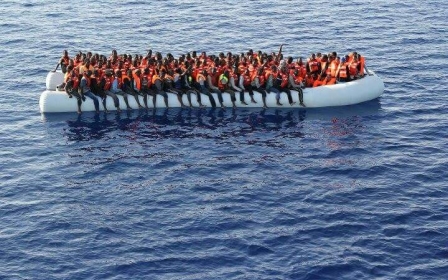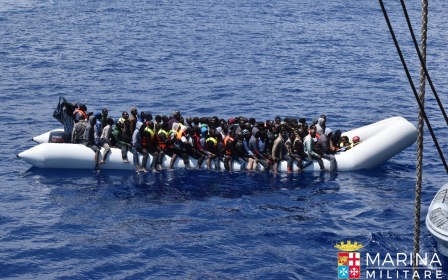Thousands mass in Libya in 'race against time' to reach Europe

Thousands of people are "racing against the clock" to make the perilous crossing from Libya to Europe before summer ends, with authorities in the conflict-torn country at a loss to stem the flow.
Abdel Hamid al-Souei of Libya's Red Crescent said improved weather triggered this week's mass outflow that has seen more than 10,000 people rescued since Sunday from floundering boats.
The migrants are "racing against the clock because they fear the start of autumn when conditions will not be so good" out at sea, he told AFP.
Dramatic images were released on Tuesday after the Italian navy launched a series of operations to rescue thousands of people from drowning in the Mediterranean Sea.
In one rescue operation footage showed around 700 people crammed into a fishing boat, with some of them jumping off the vessel in life jackets and swimming towards rescuers.
Most of the migrants from the Horn of Africa and the west of the continent set out from the Libyan town of Sabratha, just 300 kilometres (180 miles) across the Mediterranean from the Italian island of Lampedusa.
People traffickers have exploited Libya's rampant insecurity to cash in, as authorities concentrate their limited resources on combating the Islamic State (IS) group and an uphill political battle to extend their writ over the entire country.
"Our patrols have been reduced lately because the vessels are ageing and we don't have the means to control the Sabratha coast," Libya's navy chief, Colonel Ayoub Qassem, said in Tripoli.
Rescuers saved 3,000 migrants in the waters off Libya on Tuesday as they tried desperately to reach Europe, a day after a record 6,500 people were rescued in the Mediterranean.
Countless children were among those saved from drowning, including a set of five day old twins. Doctors Without Borders, which took part in the rescue operations, said they are trying to arrange for the twins to receive medical treatment.
On Tuesday morning, a woman gave birth on board one of the rescue vessels - operated by Italy's coastguard and navy as well as NGOs - as it made its way to the Italian coast.
She and her newborn were taken by speedboat to the island of Lampedusa, while the rest of the migrants made their way to several ports in Sicily, Sardinia and southern Italy.
The total number of arrivals in Italy this year now stands at 112,500, according to the UN refugee agency and the coastguard, slightly below the 116,000 recorded by the same point in 2015.
More than 3,100 people have died trying to reach Europe this year.
Burials far from home
The municipal council of Sabratha, 70km east of Tripoli and controlled by Libya's internationally backed but nationally contested Government of National Accord (GNA), warned early in the summer that their town had turned into a hub for people trafficking.
The Tripoli-based GNA has been locked in a fierce battle since May to expel IS from their coastal stronghold of Sirte, eastern Libya, while also struggling to win the backing of a rival administration operating from near the border with Egypt.
"There are parties which are profiting from the trade while the Tripoli authorities are tied up with the fight against IS," said another Red Crescent official in Sabratha, situated half-way between Tripoli and the Tunisian border, asking not to be named.
He said the traffickers, "who are often armed, are linked to an international ring operating in Libya, neighbouring Arab countries and extending all the way to Europe".
Between June and August, more than 800 African migrants aiming to reach Europe through the Libyan gateway were arrested in neighbouring Sudan along with a group of traffickers, according to Sudanese security officials.
Over the same period, underlining the mortal risks, hundreds of bodies of migrants who drowned after being dumped in the water from unseaworthy vessels washed up on Libyan beaches.
For fear of the spread of disease, civil society groups and local residents gave them anonymous burials on Libyan soil, far from the migrants' homes.
Middle East Eye propose une couverture et une analyse indépendantes et incomparables du Moyen-Orient, de l’Afrique du Nord et d’autres régions du monde. Pour en savoir plus sur la reprise de ce contenu et les frais qui s’appliquent, veuillez remplir ce formulaire [en anglais]. Pour en savoir plus sur MEE, cliquez ici [en anglais].




